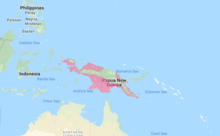Apodora
| Apodora | |
|---|---|
| Scientific classification | |
| Kingdom: | Animalia |
| Phylum: | Chordata |
| Class: | Reptilia |
| Order: | Squamata |
| Suborder: | Serpentes |
| Family: | Pythonidae |
| Genus: | Apodora Kluge, 1993 |
| Species: | A. papuana |
| Binomial name | |
| Apodora papuana | |
 | |
| Papuan python natural range | |
| Synonyms | |
| |
Apodora is a monotypic genus created for the non-venomous python species, A. papuana, commonly known as the Irian python or Papuan python. It is found in New Guinea. No subspecies are currently recognized.[2]
Description
A large snake, with adults growing to lengths of over 5 m (17 feet). However, they are not nearly as heavy bodied as other pythons, weighing in at no more than about 22.5 kg (50 lb). They are noted for having the ability to change color, though the exact mechanism and reasons for it are not completely understood. The color is reputed to change when the snake is agitated. They can vary from black to a mustard yellow, but are normally an olive green in appearance when young and dark olive when older, with the sides and underside distinctly lighter.
Distribution and habitat
Found in most of New Guinea, from Misool to Fergusson Island. The type locality given is "Ramoi Nova Guinea austro-occidentiali" (Ramoi, near Sorong, Irian Jaya, Indonesia).[1]
Behavior
Largely terrestrial and mostly nocturnal. Despite their size and impressive strength, they are relatively inoffensive animals and are not prone to bite even if handled.
Feeding
Their diet consists primarily of smaller mammals, but they are also known to be partly ophiophagous.
Captivity
The Papuan python is not commonly available in the exotic pet trade, and when they are available they command high prices. They are a relatively hardy species that adapts well to captivity, readily feeding in commercially available rats. Captive breeding has been done.
Taxonomy
This species was once classified in the genus Liasis, as well as Morelia, but was eventually moved to its own genus due to distinctive morphological characteristics.
See also
- List of pythonid species and subspecies.
- Pythonidae by common name.
- Pythonidae by taxonomic synonyms.
References
External links
| Wikispecies has information related to Apodora |
| Wikimedia Commons has media related to Apodora. |
- Apodora papuana at the Reptarium.cz Reptile Database. Accessed 9 September 2007.